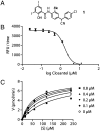Repositioning of an existing drug for the neglected tropical disease Onchocerciasis
- PMID: 20142509
- PMCID: PMC2840490
- DOI: 10.1073/pnas.0915125107
Repositioning of an existing drug for the neglected tropical disease Onchocerciasis
Abstract
Onchocerciasis, or river blindness, is a neglected tropical disease caused by the filarial nematode Onchocerca volvulus that affects more than 37 million people, mainly in third world countries. Currently, the only approved drug available for mass treatment is ivermectin, however, drug resistance is beginning to emerge, thus, new therapeutic targets and agents are desperately needed to treat and cure this devastating disease. Chitin metabolism plays a central role in invertebrate biology due to the critical structural function of chitin for the organism. Taken together with its absence in mammals, targeting chitin is an appealing therapeutic avenue. Importantly, the chitinase OvCHT1 from O. volvulus was recently discovered, however, its exact role in the worm's metabolism remains unknown. A screening effort against OvCHT1 was conducted using the Johns Hopkins Clinical Compound Library that contains over 1,500 existing drugs. Closantel, a veterinary anthelmintic with known proton ionophore activities, was identified as a potent and specific inhibitor of filarial chitinases, an activity not previously reported for this compound. Notably, closantel was found also to completely inhibit molting of O. volvulus infective L3 stage larvae. Closantel appears to target two important biochemical processes essential to filarial parasites. To begin to unravel closantel's effects, a retro-fragment-based study was used to define structural elements critical for closantel's chitinase inhibitor function. As resources towards the development of new agents that target neglected tropical diseases are scant, the finding of an existing drug with impact against O. volvulus provides promise in the hunt for new therapies against river blindness.
Conflict of interest statement
The authors declare no conflict of interest.
Figures




References
-
- Nwaka S, Hudson A. Innovative lead discovery strategies for tropical diseases. Nat Rev Drug Discov. 2006;5:941–955. - PubMed
-
- Pink R, Hudson A, Mouries M-A, Bendig M. Opportunities and challenges in antiparasitic drug discovery. Nat Rev Drug Discov. 2005;4:727–740. - PubMed
-
- Renslo AR, McKerrow JH. Drug discovery and development for neglected parasitic diseases. Nat Chem Biol. 2006;2:701–710. - PubMed
Publication types
MeSH terms
Substances
Grants and funding
LinkOut - more resources
Full Text Sources
Other Literature Sources
Molecular Biology Databases
Research Materials

